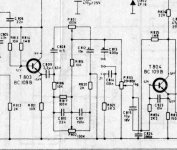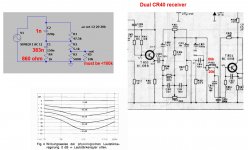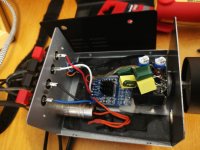ubergeeknz you could be right, I am not sure that R1 must be 10% of total resistance, I follow someone else post about loudness here on forum.
Best will be to measure some volume pot with loudness tap.
On the net I found one circuit where upper part (R1) have proportions like in your schematics:
Avian’s Blog: Dynamic Bass Boost
And one schematic of some Dual receiver (Ei Niš licence, model HiFi 70), but it is unknown which part is 20k and which 80k.
Best will be to measure some volume pot with loudness tap.
On the net I found one circuit where upper part (R1) have proportions like in your schematics:
Avian’s Blog: Dynamic Bass Boost
And one schematic of some Dual receiver (Ei Niš licence, model HiFi 70), but it is unknown which part is 20k and which 80k.
Attachments
Interesting. I'll try those values in the sim and see what the results are like. I did play around with them for best effect, but I didn't try going that low on R5.
The amplifier itself (TPA3116d2) seems to have a fairly low input impedance, hence the 10k load in my sim. Real world measurements will confirm. I don't really want to go to the effort of adding a buffer stage for what is a very simple, compact setup for listening to a Chromecast audio at my desk while I work. Indeed I'll probably dead bug the loudness circuit right onto the pot.
The amplifier itself (TPA3116d2) seems to have a fairly low input impedance, hence the 10k load in my sim. Real world measurements will confirm. I don't really want to go to the effort of adding a buffer stage for what is a very simple, compact setup for listening to a Chromecast audio at my desk while I work. Indeed I'll probably dead bug the loudness circuit right onto the pot.
according the schematic underThis is 5 pin volume pot in Grundig SV 2000 amplifier.
Many Grundig models use that double loudness.
GRUNDIG SV-2000 GB U Service Manual download, schematics, eeprom, repair info for electronics experts
this is a two stage loudness control, i. e. two different attenuations anywhere in the midrange area, unfortunately dependent of the wanted SPL (adjusted by volume control 5-pin pot).
Bad in cases, when very low level and very high level sources listen.
How get I an appropriate circuit with same loudness character, if I want to replace this potentiometer R312/313 which have two taps (5-pin) against a normal three PIN potentiometer without taps and two additional potentiometers for adjust the two different attenuations in the midrange independent of the individual resp. wanted level attenuation ?
Thanks for advices.
In this case I start a new thread, but asked question is in case of replacing of potentiometers with only one tap:
https://www.diyaudio.com/forums/sol...endent-loudness-effect-rules.html#post6462929
Last edited:
I’ve not seen any truly satisfactory ways of doing replacing 4 or 5 tap with 3 tap poti. I used to have an aversion to stepped attenuators, but my current preamp has one, and I’m not at all bothered by it.
If you can find an attenuators that has the resistors one the outside, Rather than mounted internally as some modern ones with SMD resistors do, you can have as many taps as your heart desires at any place along the taper.
Interesting that this should come up, as I was wondering this morning how people manage to listen to their systems at various levels without a loudness control. I like quiet in the background sometimes, and sometimes like listen very loud. And given how our ears work, there’s no way that I can see to have anything resembling tonally balanced sounding reproduction except at one particular sound pressure level of you dispense with loudness and/or tone controls. The fetishism to have as little as possible in the signal chain seems to have gone past the point of stripping away too much of the system to the point where they’ve removed parts of it that are necessary for basic enjoyment of sound reproduction. Unless one listens at the same level, and all sources are actually recorded perfectly...
If you can find an attenuators that has the resistors one the outside, Rather than mounted internally as some modern ones with SMD resistors do, you can have as many taps as your heart desires at any place along the taper.
Interesting that this should come up, as I was wondering this morning how people manage to listen to their systems at various levels without a loudness control. I like quiet in the background sometimes, and sometimes like listen very loud. And given how our ears work, there’s no way that I can see to have anything resembling tonally balanced sounding reproduction except at one particular sound pressure level of you dispense with loudness and/or tone controls. The fetishism to have as little as possible in the signal chain seems to have gone past the point of stripping away too much of the system to the point where they’ve removed parts of it that are necessary for basic enjoyment of sound reproduction. Unless one listens at the same level, and all sources are actually recorded perfectly...
I know. Bad solution in all cases, when either very low level or very high level sources are connected on the amp, because the attenuations for loudness effect in the mid area to weak or too strong.
Therefore I want a solution with two additional potentiometers for loudness adjust independent of the position of volume control and an appropriate network.
Therefore I want a solution with two additional potentiometers for loudness adjust independent of the position of volume control and an appropriate network.
I will make variable versions for the two additional used caps and resistors in the Yamaha approach to determine the attenuated midrange frequency area.
Check out post #5 for various basic and historic descriptions concerning loudness contour approaches - go to
https://www.diyaudio.com/forums/sol...endent-loudness-effect-rules.html#post6465588
Check out post #5 for various basic and historic descriptions concerning loudness contour approaches - go to
https://www.diyaudio.com/forums/sol...endent-loudness-effect-rules.html#post6465588
Where’s the problem in using a stepped attenuators instead of standard pot? There are options to have the steps numerous and therefore fine enough, that the stepped nature is not an issue in terms of having sufficient resolution to be truly useful. And you can have taps anywhere you like at that point.
The Macintosh c-24 and a number of others have fully variable loudness controls. Of course they manage to make for complicated/unobtainium pots by having volume level attenuation at both ends of the amplification circuit (they run power amp signal into the preamp for speaker connections and this regulate the level of both pre and power amps on the volume control for better control of background noise and more favorable s/n ratio at all volume positions, necessitating a 4 pole volume pot. And then go and put the loudness control on top of the Balance control in a few of their designs, necessitating another 4 gang pot.
The Macintosh c-24 and a number of others have fully variable loudness controls. Of course they manage to make for complicated/unobtainium pots by having volume level attenuation at both ends of the amplification circuit (they run power amp signal into the preamp for speaker connections and this regulate the level of both pre and power amps on the volume control for better control of background noise and more favorable s/n ratio at all volume positions, necessitating a 4 pole volume pot. And then go and put the loudness control on top of the Balance control in a few of their designs, necessitating another 4 gang pot.
...having volume level attenuation at both ends of the amplification circuit (they run power amp signal into the preamp for speaker connections and this regulate the level of both pre and power amps on the volume control for better control of background noise and more favorable s/n ratio at all volume positions, necessitating a 4 pole volume pot. And then go and put the loudness control on top of the Balance control in a few of their designs, necessitating another 4 gang pot.
I very well may totally miss the point, but this situation reminds me of The technique described at sound-au.com : ESP - A Better Volume Control
- Home
- Source & Line
- Analog Line Level
- Loudness stage


